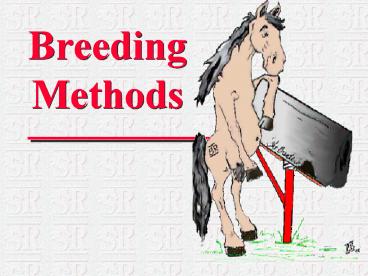Breeding Methods - PowerPoint PPT Presentation
1 / 21
Title:
Breeding Methods
Description:
permits more efficient use of stallion semen. Several can be inseminated ... AI can be use to reinforce natural service when stallion is injured or valuable. ... – PowerPoint PPT presentation
Number of Views:364
Avg rating:3.0/5.0
Title: Breeding Methods
1
Breeding Methods
2
Breeding Methods
- The first references to artificial insemination
(AI) in the horse supposedly was reported as
early as 1322. - Standardbred industry has employed widespread use
of AI since the early 1950s.
3
Breeding Methods
- Many other breed registries also allow the use of
AI. - Only three registries in the US do not permit the
use of AI. - These are the
- Jockey Club (Thoroughbreds)
- Standard Jack and Jennet Registry of America
- American Miniature Horse Association
4
Breeding Methods
- Advantages
- Dividing an ejaculate into several insemination
doses - permits more efficient use of stallion semen.
- Several can be inseminated with single ejaculate.
- No. of mares booked to a stallion each year can
be increased.
5
Breeding Methods
- The additions of antibiotics to seminal extenders
reduces venereal transmission of bacterial
diseases to the mare where the stallion serves as
a carrier. - Seminal extenders contain supportive and
protective factors for spermatozoa and may
improve pregnancy rates of some subfertile
stallions. - AI can be use to reinforce natural service when
stallion is injured or valuable.
6
Breeding Methods
- Use of a breeding phantom for seminal collection
greatly reduces the risk of injury to the
stallion. - Seminal collection allows and opportunity to
evaluate seminal quality and assist in the
detection of infertility problems. - The availability of stallion semen is increased
for mare owners.
7
Breeding Methods
- Disadvantages
- A high level of knowledge and skill are necessary
for success in an AI program. - The cost of necessary equipment and supplies is
also increased and the risk of human injury may
be greater during the collection period.
8
Breeding Methods
- Seminal collection
- Breeding Shed
- Artificial Vaginas
- CSU model
- Missouri model
- Japanese Model
- Factors to consider when purchasing AV
- Cost
- Maintain temperature
- Maintenance requirements
- Ease of handling
9
Semen Collection
10
Breeding Methods
- Preparation of the stallion
- Mount sources
- Live mare
- Breeding phantom
- General semen handling techniques
- Insemination timing and frequency
11
Breeding Methods
- Insemination Dose (Sperm number)
- Typically, mares in an AI program are inseminated
w/ 250 to 500 million progressively motile
spermatozoa from stallions. - Under ideal conditions, the insemination dose may
be reduced to 100 million PMS w/o reducing
fertility when using semen from a fertile
stallion.
12
Breeding Methods
- Insemination Volume
- Typical insemination volumes for extended equine
semen range from 10 to 25 mL. - In V desired number of pms
- (sperm conc.) ( percent pms)
13
Breeding Methods
- Insemination Procedure
- Mare in stock
- Prepare semen
- Wash mare
- Obtain the semen
- Inseminate the mare
14
Breeding Methods
- Natural Service
- The Jockey Club regulations state that any foal
that is the product of either AI or embryo
transfer is not eligible for registration. - In order to be eligible for registration, a foal
must be the result of a stallions natural
service of a mare (which is the physical mounting
of the mare by a stallion).
15
Breeding Methods
- Working under this directive, the Thoroughbred
breeding shed manager must be cognizant of - timeliness of the breeding
- concerned with mares and stallions conduct
- prevention of disease
16
Breeding Methods
- Mare Reception
- right mare to right stallion
- identification and paper work
- imported mares bred last
- veterinary certificate
- uterine culture
17
Breeding Methods
- Teasing
- important to tease every mare after she arrives.
- adequate time must be allowed for the mare to
respond. - a good teasing stud is a must
- gentle
- vocal
- aggressive enough to continue to tease day in and
day out.
18
Breeding Methods
- In some instances, mares will not show estrus
even after extensive teasing with the stallion. - Some mares are merely passive while others are
more adamant in their behaviors. - In any case, the manager must ascertain whether
the mare will allow herself to be covered by the
stallion.
19
Breeding Methods
- Preparation of the mare before breeding
- Tease and found receptive
- Tail needs to be wrapped
- External genitalia and perineal area washed
- Many sheds use mild soaps or just warm water to
wash with
20
Breeding Methods
- Evaluate the vulva
- relatively vertical vulvar lips
- little or no tilt
- good seal to prevent wind sucking or fecal
contamination. - Caslick operation
- Vulvar conformation changes
- yr to yr
- body weight and physical condition
- status
21
Breeding Methods
- The breeding shed
- Breeding shed procedures
- mare led to breeding shed
- fitted with appropriate gear
- twitched
- breeding hobbles
- mare handler
- stallion handler
- extra breeding crew (tail, breeding roll,
stallion)

